Revised June 14, 2002
References
The links below to Amazon.com, provided in association with Amazon.com, provide descriptions and reviews of the book.
Recommended
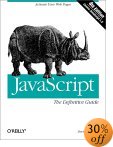 Flanagan,
David JavaScript: The Definitive Guide, Fourth Edition, 2001 ISBN 0596000480,
$44.95 list, $31.47 from Amazon.
Flanagan,
David JavaScript: The Definitive Guide, Fourth Edition, 2001 ISBN 0596000480,
$44.95 list, $31.47 from Amazon.
I found the third edition of this book to be my definitive guide to JavaScript and also well-written. (I haven't used the 4th Edition much so can't comment on the differences.) Despite my admiration for this book, I have not utilized this book as the primary text in the JavaScript courses I have taught for two reasons. First, the book is short on examples, and has no exercises. Second, although I learned JavaScript from this book, it is probably too difficult for most students in a first course on JavaScript and is a better reference book than text. However some of my best students have used this book as their primary text in my JavaScript courses and have really liked it. (Reviewed 12/01)
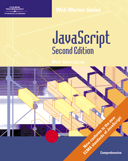 Gosselin,
Don JavaScript (Comprehensive), Second Edition, Course Technology,
2001, ISBN 0-619-06334-3, $53.95 list, $53.95 from Amazon
Gosselin,
Don JavaScript (Comprehensive), Second Edition, Course Technology,
2001, ISBN 0-619-06334-3, $53.95 list, $53.95 from Amazon
In the fall of 2001, I used the entire first edition (published November 2001) of the Comprehensive version of this text in a semester-length JavaScript course and I have used the second edition (published December 2001) in that course in Spring and Summer 2002. The Course Technology books are generally liked by students because they are "step-by-step" and have examples. The principal problems with the first edition in my view, in decreasing order of importance, were a large number of errors and some problem in organization of material. Most of the errors, largely confined to the first two chapters in the first edition, were remedied in the second edition. . I have developed an errata list for both the first and second edition. While the organization of material was generally good, some topics (e.g. the Date object, string methods, and the Math object) were dealt with later than I would have preferred and some useful JavaScript methods were omitted entirely.
Although not a great text, I plan on continuing to use this text because I don't know of a better one for an introductory semester-length course on JavaScript. (Reviewed 6/02)
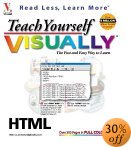 Maran,
Ruth Teach Yourself HTML Visually, IDG Books, 1999, ISBN 0-7645-3423-8.
$30 list, $20.99 from Amazon
Maran,
Ruth Teach Yourself HTML Visually, IDG Books, 1999, ISBN 0-7645-3423-8.
$30 list, $20.99 from Amazon
Filled with lots of pictures, this book covers the standard HTML topics with a couple of chapters devoted to style sheets. Although the format may give the impression that topics are not covered in depth, I found it makes most of the points I want to make in an introductory semester-length course on HTML and my students in introductory courses have liked it. (Reviewed 12/01)
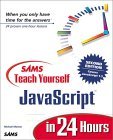 Moncur,
Michael Teach Yourself JavaScript in 24 Hours, Second Edition, October
2000, ISBN 0-672-32025-8, $24.99 list, $24.99 from Amazon
Moncur,
Michael Teach Yourself JavaScript in 24 Hours, Second Edition, October
2000, ISBN 0-672-32025-8, $24.99 list, $24.99 from Amazon
I have used this in two courses I have taught. I have liked a number of books in the Teach Yourself in 24 Hours series, including this one. Like the Teach Yourself HTML 4 in this series, this book covers a wide variety of topics with the treatment of each topic to the point.
This book is good for an introduction to JavaScript covering perhaps half of a semester. For a semester length course, a book with more detail, such as the Gosselin text, I think is better. Also, some better students I think prefer a more technical or complete treatment of topics than found in this book. (Reviewed 12/01)
 Meyers,
Paul F., The HTML Web Classroom, 1999, ISBN 0-13-796111-1. $53.33 list,
$53.33 from Amazon
Meyers,
Paul F., The HTML Web Classroom, 1999, ISBN 0-13-796111-1. $53.33 list,
$53.33 from Amazon
I have used this text for the beginning web page design/HTML courses I have taught each semester for the past two years. At about 300 pages, the treatment of topics is reasonably thorough yet the book is small enough to not be intimidating. The book covers fewer topics than Oliver's Teach Yourself HTML in 24 Hours, but in greater depth. For a beginning book, however, the topics covered are appropriate although a chapter on style sheets would be nice. My students have consistently liked this book. There are a few errors in the book, primarily typos in code. This 1998 or 1999 book has not yet come out in a second edition, but this is not a drawback, except for the previously mentioned errors. The principal drawback of this book is that it is relatively expensive (Reviewed 12/01)
 Morrison,
Mike and Morrison, Joline Database-Driven Web Sites, Course Technology,
2000, ISBN 0-619-01556-X. $53.95 list, $53.95 from Amazon
Morrison,
Mike and Morrison, Joline Database-Driven Web Sites, Course Technology,
2000, ISBN 0-619-01556-X. $53.95 list, $53.95 from Amazon
I found this Course Technology book to be extremely well-written; it was a joy to read and as good a Course Technology book as I've seen. Students like Course Technology books because they are "step by step". The principal issue with this book is its coverage of Microsoft technologies in the second half of the book to the exclusion of other technologies. For example: Chapter 6 teaches Visual Basic to create Web-Based Database applications. Chapter 7 teaches VBScript for client-side scripting even though JavaScript is MUCH more commonly used in client-side scripting. Chapter 8 teaches VBScript for use in Active Server Pages, and Chapter 9 ActiveX DLLs. However the text consistently notes the platform limitations of these technologies. (Reviewed 12/01)
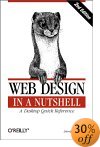 Niederst,
Jennifer Web Design in a Nutshell, Second Edition, 2001, ISBN 0-596-00196-7,
$29.95 list, $20.97 from Amazon.
Niederst,
Jennifer Web Design in a Nutshell, Second Edition, 2001, ISBN 0-596-00196-7,
$29.95 list, $20.97 from Amazon.
(My comments are on the first edition of this book; I have not used the second edition sufficiently to comment on changes made there.) This book can be used in both a beginning and an advanced HTML/web page design course although I think the issues involved in its use are different between these two cases. For a beginning course, Chapters 5-12 cover HTML topics and Chapter 23 cover style sheets with greater thoroughness than I teach in my beginning HTML course, and a few of my better students have used this book as a supplementary text and liked it a great deal. For an advanced course, because the book covers a wide variety of topics, as a sole text for a course, it would be most suited to a course with a similarly wide focus rather than a course where a significant emphasis would be placed on a particular topic, for example, and in particular, JavaScript. Because the book is relatively inexpensive, it might be used in such an advanced course in conjunction with another book that would provide greater emphasis on a particular topic. (Reviewed 12/01)
 Oliver,
Dick Teach Yourself HTML 4 in 24 Hours, Fourth Edition, 1999, ISBN
0-672-31369-3, $19.99 list, $19.99 from Amazon
Oliver,
Dick Teach Yourself HTML 4 in 24 Hours, Fourth Edition, 1999, ISBN
0-672-31369-3, $19.99 list, $19.99 from Amazon
I bought the third edition of this book to supplement the professor's handouts in a course in which I was learning HTML. The latest, and fourth edition, of this book was published in September 1999. This book is part of the SAMS Teach Yourself in 24 Hours series. Although I have not liked all books I have seen in this series, I have liked a number of them, including this one. This book covers a wide variety of topics. Each chapter is only 15-20 pages and so the discussion of each topic is to the point. The book also has very few errors. Priced at $19.99, it compares very favorably with other HTML books at the low price end of the spectrum. It is a good book to learn HTML, although because each topic is not covered in great depth, students who progress in the subject will probably use other books as reference material rather than this one. (Reviewed 12/01)
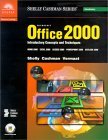 Shelly,
Gary; Cashman, Thomas; and Vermaat, Misty Microsoft Office 2000 Introductory
Concepts and Techniques, Course Technology, 2000. ISBN 0-7895-4635-3 (Perfect
bound), 0-7895-4650-7 (Spiral bound), 0-7895-5615-4 (Hard cover), all about
$63.95 list and from Amazon
Shelly,
Gary; Cashman, Thomas; and Vermaat, Misty Microsoft Office 2000 Introductory
Concepts and Techniques, Course Technology, 2000. ISBN 0-7895-4635-3 (Perfect
bound), 0-7895-4650-7 (Spiral bound), 0-7895-5615-4 (Hard cover), all about
$63.95 list and from Amazon
This is a very good text that fits well a semester length introduction to Microsoft Office covering the following topics - Windows, Word, Excel, Access, PowerPoint, and using these tools together. The only portion of this 1080 page book I skipped in this course was the chapter on Outlook due to lab constraints. The book is very step-by-step, and provides the 3-4 different ways (keyboard shortcuts, menu items, toolbars, etc.) that most things can be done in Microsoft Office without burying this in examples. There are essentially no errors in this book and it covers the right topics in generally the right order.
This book also comes in an enhanced version covering Windows 2000 instead of Windows 98 published March 2001 (ISBN 0-7895-6251-0, $66.95) While these prices are high, they are somewhat less than the corresponding Office 2000 & Windows Prentice Hall volume by Grauer & Barber, and I think better in quality. (Reviewed 12/01)
 Towers,
J. Tarin Macromedia Dreamweaver for Windows and Macintosh, Peachpit
Press, 2001, ISBN 0-201-73430-3. $21.99 list, $15.39 from Amazon.
Towers,
J. Tarin Macromedia Dreamweaver for Windows and Macintosh, Peachpit
Press, 2001, ISBN 0-201-73430-3. $21.99 list, $15.39 from Amazon.
This is the first Dreamweaver book I've read so as of now, I don't have anything
to compare it to. The approach in the book is to describe how to use various
features of the program. There are no extended examples or files to work with
which some students may miss. As a Peachpit Press book, the book is attractively
priced. (Reviewed 6/14/02)
 Williams,
Robin and Tollett, John The Non-Designer's Web Book, Second Edition,
September 2000, ISBN 0201710382 $34.99 list, $24.49 from Amazon
Williams,
Robin and Tollett, John The Non-Designer's Web Book, Second Edition,
September 2000, ISBN 0201710382 $34.99 list, $24.49 from Amazon
Although I have not seen this edition, the first edition was very nice book about designing web pages, with virtually no HTML details.
Mixed feelings:
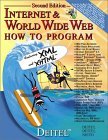 Deitel,
H. M.; Deitel, P.J. Deitel, and Nieto, T. R. Internet and World Wide Web:
How to Program, Prentice Hall, Second Edition, 2001, ISBN 0-13-016143-8. $76
list, $76 from Amazon
Deitel,
H. M.; Deitel, P.J. Deitel, and Nieto, T. R. Internet and World Wide Web:
How to Program, Prentice Hall, Second Edition, 2001, ISBN 0-13-016143-8. $76
list, $76 from Amazon
(My comments are about the first edition of this book; I have not seen the second edition.) I have talked to six people in two different courses (5 students and one professor) about the first edition of this book and all but one didn't like it. The good points are that it presents detailed information often not found in other textbooks, and it covers a wide variety of topics. My reading of the book was mostly confined to the HTML and JavaScript chapters. I found the HTML chapters (Ch. 4-5) to be poorly organized, and the JavaScript chapters (Ch. 8-13) to be an adaptation of 2 of the authors' How to Program Java book. The problem with this Java to JavaScript rewrite is that it makes it too "computer sciency", making JavaScript appear as difficult to learn as Java, and the examples do not focus on how JavaScript is typically used.
Because of the wealth of material covered in this book, it may be useful as a supplementary text, although its price would likely preclude that in many cases. I found Database-Driven Web Sites by Morrison & Morrison (reviewed above) to be a much better book on this general topic, although it is less extensive. (Reviewed 12/01)
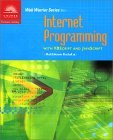 Kalata,
Kathleen Internet Programming with VBScript and JavaScript, Course
Technology, 2000, 0-619-01523-2. $41.95 list, $41.95 from Amazon
Kalata,
Kathleen Internet Programming with VBScript and JavaScript, Course
Technology, 2000, 0-619-01523-2. $41.95 list, $41.95 from Amazon
A number of the chapters provide both JavaScript and VBScript code. While this may be useful for someone with background in one or both languages, to a beginner who knows neither this approach is likely to be confusing. There are a number of errors in the JavaScript sections of the book, particularly Chapter 3 -- I have written errata pages for the following chapters: Chapter 1, Chapter 2, Chapter 3, Chapter 5, Chapter 6. (Reviewed 1/02)
 Lynch,
Patrick J. and Horton, Sarah Web Style Guide: Basic Design Principles for
Creating Web Sites, 1999, ISBN 0-300-07675-4, $15.95 list, $15.95 from
Amazon
Lynch,
Patrick J. and Horton, Sarah Web Style Guide: Basic Design Principles for
Creating Web Sites, 1999, ISBN 0-300-07675-4, $15.95 list, $15.95 from
Amazon
I don't think this book is particularly helpful to people who are just starting out, and for people who are more experienced, I think there are better books, albeit more expensive.
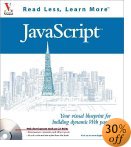 Murdock,
Kelly L. JavaScript: Your visual blueprint for building dynamic Web pages,
IDG Books, 2000, ISBN 0-7645-4730-5. $24.99 list, $17.49 from Amazon
Murdock,
Kelly L. JavaScript: Your visual blueprint for building dynamic Web pages,
IDG Books, 2000, ISBN 0-7645-4730-5. $24.99 list, $17.49 from Amazon
I found the code sections too small and difficult to read and so I gave up on this book after a few pages.
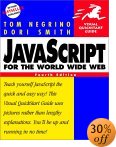 Negrino,
Tom and Smith, Dori JavaScript for the World Wide Web: Visual Quickstart
Guide, 4th edition, 2001, ISBN 0-201-73517-2, $19.99 list, $13.99 from
Amazon
Negrino,
Tom and Smith, Dori JavaScript for the World Wide Web: Visual Quickstart
Guide, 4th edition, 2001, ISBN 0-201-73517-2, $19.99 list, $13.99 from
Amazon
The strong points of the 3rd edition (4th edition published April 2001) of
this Peachpit Press book are its exceptionally-low price ($17.99) and the
wealth of JavaScript examples. However, I found this book to be little more
than a book of examples. For example, there is no discussion of "core" vs.
client-side JavaScript, the Document Object Model, variable scope, operator
precedence, etc. From this book the student would have no conceptual framework
for JavaScript. Thus I would not recommend it either as a primary text or
reference book. As an introductory text, I prefer the SAMS Teach Yourself
JavaScript in 24 Hours to this book. However, because of its low price and
emphasis on examples, it might be a useful supplementary book in a course.
(Reviewed 12/01)
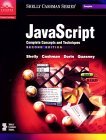 Shelly,
Gary B., Cashman, Thomas J, Dorin, William JavaScript Introductory Concepts
& Techniques, Second Edition, Shelly Cashman Series, Course Technology,
2000, ISBN 0-7895-6233-2. I was also disappointed with this book and
the number of errors. Amazon
link
Shelly,
Gary B., Cashman, Thomas J, Dorin, William JavaScript Introductory Concepts
& Techniques, Second Edition, Shelly Cashman Series, Course Technology,
2000, ISBN 0-7895-6233-2. I was also disappointed with this book and
the number of errors. Amazon
link
Essentially Unreviewed:
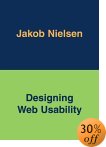 Nielsen,
Jakob Designing Web Usability: The Practice of Simplicity, 2000, ISBN
1-56205-810-X, $45 list, $31.50 from lAmazon.
I've only read the first 40 pages of this book but was quite impressed with
it as a book on style and design.
Nielsen,
Jakob Designing Web Usability: The Practice of Simplicity, 2000, ISBN
1-56205-810-X, $45 list, $31.50 from lAmazon.
I've only read the first 40 pages of this book but was quite impressed with
it as a book on style and design.